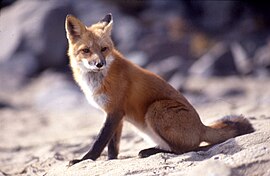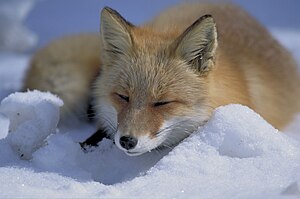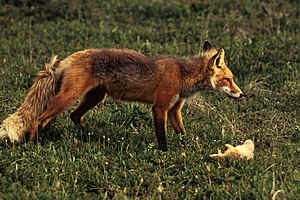Red fox: Difference between revisions
No edit summary |
delete cat fauna of GA - animal range too broad to list by state - should just be in SE US |
||
| Line 99: | Line 99: | ||
[[Category:Fauna of Canada]] |
[[Category:Fauna of Canada]] |
||
[[Category:Fauna of the United States]] |
[[Category:Fauna of the United States]] |
||
[[Category:Fauna of Georgia (U.S. state)]] |
|||
[[Category:Fauna of Southeastern United States]] |
[[Category:Fauna of Southeastern United States]] |
||
[[Category:Mammals of Asia]] |
[[Category:Mammals of Asia]] |
||
Revision as of 13:43, 21 October 2006
| Red Fox | |
|---|---|

| |
| Scientific classification | |
| Kingdom: | |
| Phylum: | |
| Class: | |
| Order: | |
| Family: | |
| Genus: | |
| Species: | V. vulpes
|
| Binomial name | |
| Vulpes vulpes Linnaeus, 1758
| |
| Synonyms | |
|
Vulpes fulva, Vulpes fulvus | |
The Red Fox (Vulpes vulpes) is the most familiar of the foxes. In Britain and Ireland, where there are no longer any other native wild canids, it is referred to simply as the "Fox". It has the widest range not just of any fox but of any terrestrial carnivore. As its name suggests, its fur is predominantly reddish-brown, but there is a naturally occurring grey morph, the Silver Fox; a remarkable strain of tame Silver Fox has been produced from these animals by systematic domestication.
Distribution

The largest species within the genus Vulpes, the Red Fox has a native range spanning most of North America and Eurasia, with several populations in North Africa. A subspecies, the Japanese Red Fox (Vulpes vulpes japonica) migrated from India to China and eventually to Japan. It is also known by the Japanese name kitsune (狐). The Red Fox has been introduced to Australia, where it poses a serious conservation problem.[2]
Three subspecies of Red Fox are found in India: Vulpes vulpes montana (the Tibetan Fox), found in Ladakh and the Himalayas, Vulpes vulpes griffithi (the Kashmir Fox) found in Jammu and Kashmir less the Ladakh sector, and Vulpes vulpes pusilla (the Desert Fox) found in the Thar desert of Rajasthan and in Kutch, Gujarat.
Physical description

The Red Fox is most commonly a rusty red, with white underbelly, black ear tips and legs, and a bushy tail with a distinctive white tip. The "red" tone can vary from crimson to golden, and in fact can be brindled or agouti, with bands of red, brown, black and white on each individual hair when seen close up.
In the wild, two other color phases are also seen. The first is silver or black, comprising 10% of the wild population and most of the farmed. Approximately 30% of wild individuals have additional black patterning, which usually manifests as a stripe across the shoulders and down the center of the back. This pattern forms a "cross" over the shoulders, hence the term "cross fox". "Domesticated" or farmed stock may be almost any color, including spotted, or "marbled", varieties.
The fox's eyes are gold to yellow and have distinctive vertically slit pupils, similar to those of a feline. They can see just as well too, and combined with their extreme agility for a canid the Red Fox has been referred to as "the cat-like canid". Its long bushy tail with distinctive white tip provides balance for acrobatic leaps and bounds. Its strong legs allow it to reach speeds of 45 miles per hour. That amazing speed makes it easy for them to catch their prey or to outrun their predators.
The Red Fox may reach an adult weight of 2.7-6.8 kg (6-15 lb),[3] but this varies from region to region; European individuals being larger, on average, than those in North America.
During the autumn and winter, the Red Fox will grow more fur. This so-called 'winter fur' keeps the animal warm in the colder environment. The fox sheds this fur at the onset of spring, reverting back to the short fur for the duration of the summer.
Habitat and diet

The Red Fox is found in a variety of biomes, from prairies and scrubland to forest settings. It is most suited to lower latitudes but does venture considerably far north, competing directly with the Arctic Fox on the tundra. The Red Fox has also become a familiar sight in suburban and even urban environments both in Europe and in North America, where it shares territory with the much maligned raccoon.
The Red Fox eats rodents, insects, fruits, worms, eggs, mice, birds, and other small animals. It has 42 very powerful teeth that they use to catch their food. The fox regularly consumes from 0.5–1 kg (1–2 lb) of food per day. In urban neighbourhoods, the fox probably depends mainly on scavenging household waste, though it will also take rodents and birds from gardens and wasteland.
Since it is so adaptable, it has a strong population that is above 20 million.
Behaviour
Living as it does in a wide variety of habitats, the Red Fox displays a wide variety of behaviours. In Biology and Conservation of Wild Canids, MacDonald and Sillero-Zubiri state that two populations of the Red Fox may be behaviorally as different as two species.
The Red Fox is primarily crepuscular with a tendency to becoming nocturnal in areas of great human interference (and artificial lighting); that is to say, it is most active at night and at twilight. It is generally a solitary hunter. If a fox catches more food than it can eat, it will bury the extra food (cache) to store it for later.
In general, each fox claims its own territory; it pairs up only in winter, foraging alone in the summer. Territories may be as large as 50 square kilometres (19 square miles); ranges are much smaller (<12 square kilometres (4.6 square miles)) in habitats with abundant food sources, however. Several dens are utilized within these territories; dens may be claimed from previous residents such as marmots, or dug anew. A larger main den is used for winter living, birthing and rearing of young; smaller dens are dispersed throughout the territory for emergency and food storage purposes. A series of tunnels often connects them with the main den.
The Red Fox has been considered a monogamous species, however evidence for polygamy (polygyny and polyandry) includes males’ extra territorial movements during breeding season (possibly searching for additional mates) and males’ home ranges overlapping two or more females’ home ranges. Such variability is thought to be linked to variation in the spatial availability of key resources such as food.[1]
The Red Fox primarily forms monogamous pairs each winter, which cooperate to raise a litter of 4–6 kits (also called pups) each year; but in various locales and for various incompletely explored reasons they may also practice polygamy (multiple males sharing a single female and/or vice versa). Sometimes young foxes disperse promptly on maturity (approx. 8-10 months); sometimes they remain in their natal territory and assist in raising the next year's offspring.
The reason for this "group living" behaviour is not well understood; some researchers believe the non-breeders boost the survival rate of the litters while others believe there is no significant difference, and such arrangements are made spontaneously due to a resource surplus.
Socially, the fox communicates with body language and a variety of vocalizations. Its vocal range is quite large and its noises vary from a distinctive three-yip "lost call" to a shriek reminiscent of a human scream. It also communicate with scent, marking food and territorial boundary lines with urine and feces.
Reproduction

The Red Fox breeding period varies widely due to its broad distribution; southern populations breed from December to January, central populations from January to February and northern populations from February to April. Females have an annual estrous period of between 1–6 days; ovulation is spontaneous. Copulation is loud and short, usually lasting no more than 20 seconds. Although a female may mate with several males (who fight amongst each other for the right), she will eventually settle with only one.

Males will supply food to females up to and after birthing, otherwise leaving the female alone with her kits (also called cubs or pups) in a "maternity den". An average litter size is 5 kits, but may be as large as 13. Kits are born blind and may weigh as much as 150 grams (0.33 pounds). Their eyes are open by two weeks and the kits have taken their first exploratory steps out of the den by five weeks; by 10 weeks they are fully weaned.
In autumn of the same year, the young foxes will disperse and claim their own territories. The Red Fox reaches sexual maturity by 10 months of age, and may live for 12 years in captivity but usually live 3 years in the wild.
Foxes and humans
The Red Fox has both positive and negative standing with humans, often being loved or hated. This has been most visible in the United Kingdom where fox hunting with dogs was a traditional sport, until this was made illegal on February 18 2005. The fox features in much folklore, usually as a wily villain, though sometimes also as the underdog who triumphs over human efforts to control or destroy it.
Like other wild animals, foxes are considered vectors of disease. The Red Fox helps farmers by preying on animals that damage crops but are considered to be a pest by farmers involved in poultry farming. The Red Fox is of some importance in the fur industry.
Greater visibility in nature documentaries and sympathetic portrayals in fiction have improved the Red Fox's reputation and appeal in recent years. A prominent cultural impact is that on fox hunting which became illegal in Scotland in August 2002 and in England and Wales in February 2005.
Conservation problems of feral foxes in Australia
Feral foxes in Australia pose a serious conservation problem. According to the Australian Government, the Red Fox was introduced to Australia for hunting in 1855, but has since become wide-spread, and is considered responsible for the decline in a number of species of native animals. In a program known as Western Shield, Western Australia state government authorities conduct aerial and hand baiting on almost 35,000 km² (8.75 million acres) to control foxes and feral cats. The West Australian conservation department, CALM, estimates introduced predators are responsible for the extinction of 10 native species in that state, while Western Shield targets the conservation of 16 others. In Tasmania, the possibility of foxes in the wild has caused considerable concern as the island state had been fox-free for a considerable time in its history.
References
- ^ a b Template:IUCN2006 Database entry includes justification for why this species is of least concern
- ^ http://www.deh.gov.au/biodiversity/invasive/publications/fox/index.html
- ^ "Living with Fox in Massachusetts".
- Menon, Vivek. A Field Guide to Indian Mammals. Dorling Kindersley, Delhi, 2003.
- MacDonald, David (1991). Running with the Fox. Facts on File. ISBN 0-8160-1886-3.
- Australian Department of the Environment and Heritage fact sheet, 2004
External link
- "Vulpes vulpes". Integrated Taxonomic Information System. 18 March.
{{cite web}}: Check date values in:|date=and|year=/|date=mismatch (help) - The Fox Forest.
- Least concern species
- Foxes
- Mammals of Europe
- Fauna of Japan
- Fauna of Belgium
- Fauna of Canada
- Fauna of the United States
- Fauna of Southeastern United States
- Mammals of Asia
- Mammals of India
- Mammals of Pakistan
- Mammals of Estonia
- Mammals of Africa
- Wildlife of North America
- Fauna of Morocco
- Fauna of Algeria
- Fauna of Egypt
- Fauna of Sudan
- Fauna of Scotland
- Mammals of Australia
- Mammals of Lithuania
- Fauna of Ireland
- Fauna of Italy
- Fauna of Lombardy
- Introduced animals
